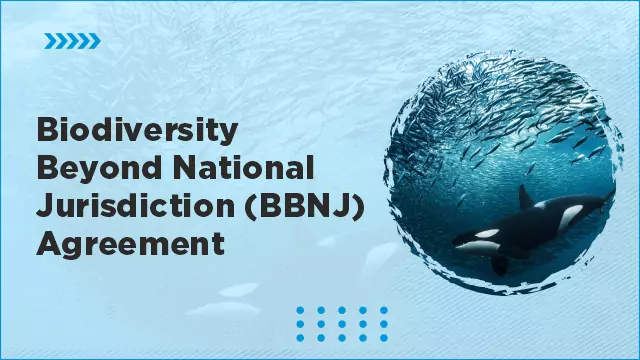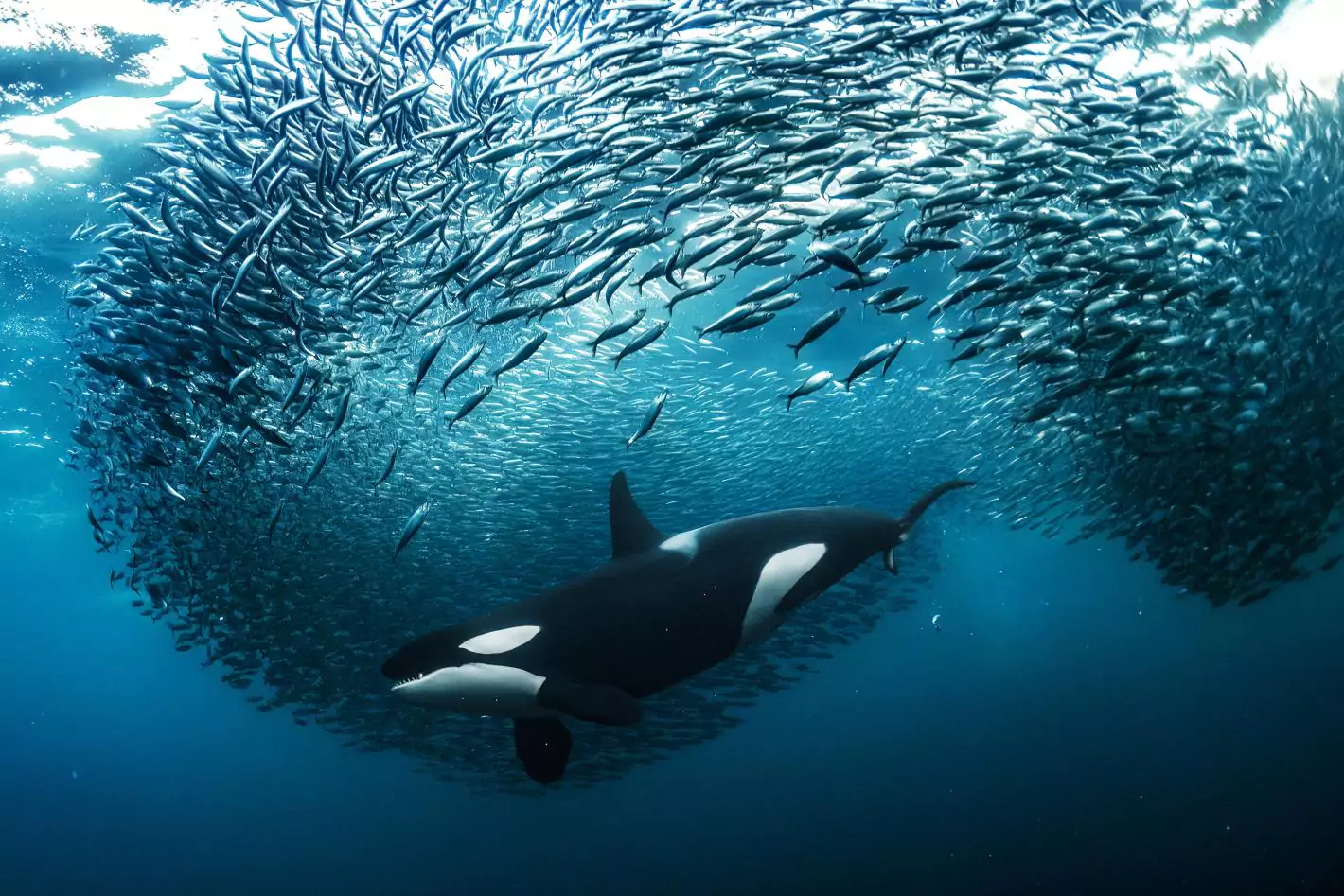Biodiversity Beyond National Jurisdiction (BBNJ) Treaty
The Biodiversity Beyond National Jurisdiction (BBNJ) Treaty, also called the High Seas Treaty, is a landmark international agreement under the United Nations Convention on the Law of the Sea (UNCLOS). It was finalized in March 2023 and aims to protect marine biodiversity in international waters, which cover over 64% of the global ocean. This treaty is crucial in addressing threats like overfishing, pollution, and climate change in the high seas.
What is the BBNJ Treaty?
- Official Name: Agreement on the Conservation and Sustainable Use of Marine Biological Diversity of Areas Beyond National Jurisdiction (BBNJ).
- Also Known As: High Seas Treaty.
- Legal Basis: It is an implementation agreement under UNCLOS (United Nations Convention on the Law of the Sea).
- Adopted: March 2023.
- Signatories: 91 countries have signed so far; 60 ratifications are required for it to come into force.
Importance in Protecting Marine Biodiversity
The high seas are vital for global biodiversity, climate regulation, and human well-being. However, due to the lack of ownership, they suffer from overexploitation and environmental degradation. The BBNJ Treaty introduces legal protections and governance mechanisms to address these challenges.
Key Objectives of the Treaty
- Establishment of Marine Protected Areas (MPAs):
- Currently, only 44% of the high seas are protected.
- The treaty aims to increase this percentage significantly in alignment with the 30x30 target (protecting 30% of the planet’s land and oceans by 2030).
- Fair and Equitable Sharing of Marine Genetic Resources (MGR):
- The treaty establishes rules for sharing benefits from marine genetic resources, which could be used for biotechnology, medicine, and pharmaceuticals.
- Mandatory Environmental Impact Assessments (EIA):
- Any human activity in international waters (e.g., fishing, deep-sea mining, oil exploration) must undergo an Environmental Impact Assessment (EIA) before approval.
- Capacity Building and Technology Transfer:
- Developing nations will receive technical and financial support to participate in marine resource conservation.
Why Is the BBNJ Treaty Important for Global Biodiversity?
The Biodiversity Beyond National Jurisdiction (BBNJ) Treaty plays a crucial role in protecting marine biodiversity by addressing key challenges related to conservation, climate change, and international cooperation.
- Addressing the "Global Commons" Challenge
- The high seas cover 64% of the world's oceans and 50% of Earth's surface, yet they remain largely unregulated.
- Marine biodiversity in these areas is threatened by overfishing, pollution, deep-sea mining, and habitat destruction.
- The BBNJ Treaty establishes a legal framework to prevent biodiversity loss and overexploitation by creating Marine Protected Areas (MPAs) and mandatory Environmental Impact Assessments (EIA).
- Combatting Climate Change & Marine Pollution
- Oceans play a vital role in climate regulation by absorbing carbon dioxide (CO₂) and storing heat.
- Marine biodiversity is under threat from ocean acidification, rising temperatures, oil spills, and plastic pollution.
- The treaty introduces rules for sustainable fishing, regulates industrial activities, and strengthens ocean governance to limit pollution and carbon emissions.
- Strengthening International Cooperation
- The high seas lack a centralized governance system, leading to fragmented conservation efforts.
- The BBNJ Treaty creates a legal mechanism for collaboration between nations, research institutions, and conservation groups.
- It supports global efforts like the Sustainable Development Goals (SDG 14 - Life Below Water), helping to protect marine life through coordinated international action.
Challenges in Implementing the Treaty
While the Biodiversity Beyond National Jurisdiction (BBNJ) Treaty is a significant step towards marine conservation, its implementation faces multiple logistical, financial, and political hurdles.
- Delayed Ratification
- Although 91 countries have signed the treaty, only a few have ratified it.
- The treaty will come into force 120 days after at least 60 countries complete ratification.
- The ratification process varies by country, depending on domestic legal frameworks, parliamentary approvals, and diplomatic negotiations.
- Many nations, especially developing and small island countries, have limited legal and institutional capacity to fast-track the process.
- Lack of Funding & Resources
- The treaty's implementation requires significant financial
investment to:
- Monitor and enforce compliance in vast and remote ocean areas.
- Conduct Environmental Impact Assessments (EIA) before allowing economic activities like fishing or seabed mining.
- Establish and manage Marine Protected Areas (MPAs) to conserve biodiversity.
- Transfer marine technology and scientific expertise to developing countries.
- Currently, no global fund exists to support developing nations in implementing treaty obligations.
- The lack of financial mechanisms could lead to disproportionate burdens on lower-income nations.
- The treaty's implementation requires significant financial
investment to:
- Enforcement Issues in the High Seas
- The high seas cover 64% of the world’s oceans, yet no single country has authority over them.
- This creates difficulties in monitoring and enforcing regulations,
especially against:
- Illegal, Unreported, and Unregulated (IUU) fishing.
- Deep-sea mining and industrial activities that harm marine ecosystems.
- Plastic pollution, oil spills, and chemical waste dumping.
- Since the treaty depends on voluntary compliance by signatory countries, a lack of global enforcement mechanisms could reduce its effectiveness.
- Conflicts Between Economic Interests and Conservation Goals
- Nations with strong commercial fishing and deep-sea mining industries might resist strict regulations.
- Some developed nations have concerns about profit-sharing from marine genetic resources (MGR), which could impact the biotechnology and pharmaceutical industries.
- Balancing economic development and marine conservation will require strong international negotiations and compromises.
- Coordination Between Multiple International Organizations
- Several existing international organizations already regulate specific
aspects of the high seas, such as:
- International Seabed Authority (ISA) – governs seabed mining.
- Regional Fisheries Management Organizations (RFMOs) – oversee fishing activities.
- International Maritime Organization (IMO) – regulates shipping and pollution control.
- Integrating the BBNJ Treaty with these existing frameworks without conflicts or overlaps remains a challenge.
- Several existing international organizations already regulate specific
aspects of the high seas, such as:

Significance of the BBNJ Treaty for India
India has officially endorsed the BBNJ Treaty and plans to ratify it soon. The treaty aligns with India’s ocean conservation goals, its Blue Economy Strategy, and its Indo-Pacific vision.
How the Treaty Benefits India
- Strengthening India’s Global Leadership in Ocean Governance
- By ratifying and supporting the treaty, India can position itself as a leader in global ocean conservation.
- It enhances India’s role in UN-led climate and biodiversity
initiatives, particularly those related to:
- Sustainable Development Goal 14 (Life Below Water)
- UNCLOS and high-seas biodiversity protection
- Marine Protected Areas (MPAs) and ocean health monitoring.
- India can use its diplomatic influence to shape the treaty’s implementation in the Indo-Pacific region, where it has strategic maritime interests.
- Boosting India’s Economic Interests in the Blue Economy
- The treaty provides India access to Marine Genetic Resources (MGR),
which have potential applications in:
- Pharmaceuticals (e.g., marine-derived antibiotics and anti-cancer drugs).
- Biotechnology (e.g., enzymes for industrial use).
- Sustainable food production (e.g., algae-based nutrition and marine farming).
- Sustainable fisheries management under the treaty can protect India’s fishing industry, ensuring long-term benefits for coastal communities.
- With a strong Blue Economy Strategy, India can tap into ocean-based industries while maintaining environmental sustainability.
- The treaty provides India access to Marine Genetic Resources (MGR),
which have potential applications in:
- 3. Aligning with India’s Maritime Strategy (SAGAR Initiative)
- The treaty aligns with India's Security and Growth for All in the Region
(SAGAR) initiative, which focuses on:
- Marine resource conservation in the Indian Ocean Region.
- Combating illegal fishing and marine pollution.
- Strengthening India’s leadership in Indo-Pacific maritime cooperation.
- As a country with a vast Exclusive Economic Zone (EEZ) and extensive coastline, India can leverage the treaty to enhance regional ocean governance.
- The treaty aligns with India's Security and Growth for All in the Region
(SAGAR) initiative, which focuses on:
- Enhancing India’s Climate Resilience and Environmental Goals
- India is highly vulnerable to climate change impacts like rising sea levels, ocean acidification, and marine heatwaves.
- The treaty’s focus on marine biodiversity conservation and carbon
sequestration will support India’s:
- Climate adaptation strategies (e.g., protecting coral reefs and mangroves).
- Fisheries management policies to prevent resource depletion.
- Sustainable development commitments under Paris Agreement and COP15 biodiversity targets.
- Strengthening Maritime Security and Regional Stability
- India’s strategic position in the Indo-Pacific means it has a strong interest in maintaining a stable, rules-based maritime order.
- By participating in the treaty, India can contribute to international
efforts to:
- Prevent overexploitation of marine resources in disputed waters.
- Enhance naval cooperation and surveillance to monitor illegal activities.
- Support regional partners (like small island nations) in building ocean governance capacities.
Way Forward
- Ratification & Global Cooperation: Countries must ratify and implement the treaty to strengthen marine biodiversity governance.
- Funding & Technology Support: Need for financial mechanisms to help developing nations implement the treaty.
- Monitoring & Compliance: Establishing international oversight to track compliance and prevent illegal activities in high seas.
Way Forward for India
Fast-Track Ratification & Implementation
- India should ratify the treaty quickly to gain a leadership position in its implementation.
- Strengthening domestic legal and institutional frameworks will help align India's policies with the treaty's objectives.
Invest in Ocean Conservation & Technology
- Establish a national funding mechanism to support marine conservation programs.
- Invest in marine research, surveillance technologies, and capacity building for better treaty enforcement.
Strengthen Regional & International Cooperation
- Work with Indo-Pacific nations and international bodies to ensure effective enforcement of the treaty.
- Collaborate with marine science institutions to improve sustainable fishing and resource management.
Ensure Equitable Benefit-Sharing
- Push for fair access to Marine Genetic Resources (MGR) and prevent monopolization by developed nations.
- Advocate for stronger financial and technical support for developing countries under the treaty framework.
The BBNJ Treaty is a milestone in ocean conservation. By addressing marine pollution, overfishing, and climate change, it can safeguard the high seas for future generations. India's active participation in the treaty strengthens its global maritime leadership and aligns with its sustainable development goals (SDG 14—Life Below Water).
The BBNJ Treaty is a game-changer for marine biodiversity protection. If successfully implemented, it could transform high seas governance, ensuring a balanced approach to conservation and sustainable use of marine resources. India's commitment to this treaty not only strengthens its environmental credentials but also positions it as a leader in global ocean governance.













